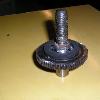Mike-in-Maine
Active Member
- Joined
- August 10, 2013
- Messages
- 53
- Reaction score
- 1
- City, State
- Lewiston, ME
- Year, Model & Trim Level
- 2003 & 2005 Explorer
Crap! I'm replacing the Drivers-side cam cartridge, and jackshaft sprockets, tensioners and chains on my 4dr. 2003 Explorer 4.0 SOHC. (got the kit)... The tear down was easy, got everything ready... Unfortunately I made the mistake of NOT double checking what to expect when doing this job.. I didn't get the cam locking tool yet and I wrongly assumed that If I kept everything from moving I could loosen the the jackshaft sprocket bolt to replace that chain and sprocket and then LATER lock the cam sprocket afterwards when I was ready to replace the Cam chain, sprockets and tensioners. WRONG! The second I loosened the Jackshaft sprocket bolt... (*pop*) the drivers side cam relaxed and rotated a bit. On top of this, I had not yet set the crank TDC. I again wrongly assumed I could wait to set to TDC when I was ready to do the cam sprocket. I assumed the jackshaft sprocket and cam sprockets on the jackshaft were keyed. I guess they are not!
So here is my dilemma. (again I know I screwed up by not reading up BEFORE loosening the jackshaft sprocket bolt)... The crank is not at TDC and the drivers side cam has moved slightly. I did carefully remove the jackshaft sprockets and chain and replace in exact position (crank and jackshaft did not move) and have the new jackshaft tensioners in place (old ones were trashed)... but as noted, the cam relaxed and rotated slightly to a comfortable spot when that jackshaft sprocket bolt was loosened. I also seem to understand this now that by loosening the jackshaft sprocket bolt the passenger side cam also is out of time? (i.e. I need to time BOTH cams?)
What to do?? I am so used to conventional OHV single cam engines that this one really caught me in a moment of ignorance.... I suppose the first task is to get to TDC without mashing valves? the drivers side cam sprocket and chain have NOT been removed, nor has the cam sprocket bolt been loosened. Am I correct in thinking that both cams are timed correctly to one another and the only challenge is getting the cran k back in time with the jackshaft (which drives both cam's driven gears)
THANKS to any who choose to help me out here!
So here is my dilemma. (again I know I screwed up by not reading up BEFORE loosening the jackshaft sprocket bolt)... The crank is not at TDC and the drivers side cam has moved slightly. I did carefully remove the jackshaft sprockets and chain and replace in exact position (crank and jackshaft did not move) and have the new jackshaft tensioners in place (old ones were trashed)... but as noted, the cam relaxed and rotated slightly to a comfortable spot when that jackshaft sprocket bolt was loosened. I also seem to understand this now that by loosening the jackshaft sprocket bolt the passenger side cam also is out of time? (i.e. I need to time BOTH cams?)
What to do?? I am so used to conventional OHV single cam engines that this one really caught me in a moment of ignorance.... I suppose the first task is to get to TDC without mashing valves? the drivers side cam sprocket and chain have NOT been removed, nor has the cam sprocket bolt been loosened. Am I correct in thinking that both cams are timed correctly to one another and the only challenge is getting the cran k back in time with the jackshaft (which drives both cam's driven gears)
THANKS to any who choose to help me out here!












